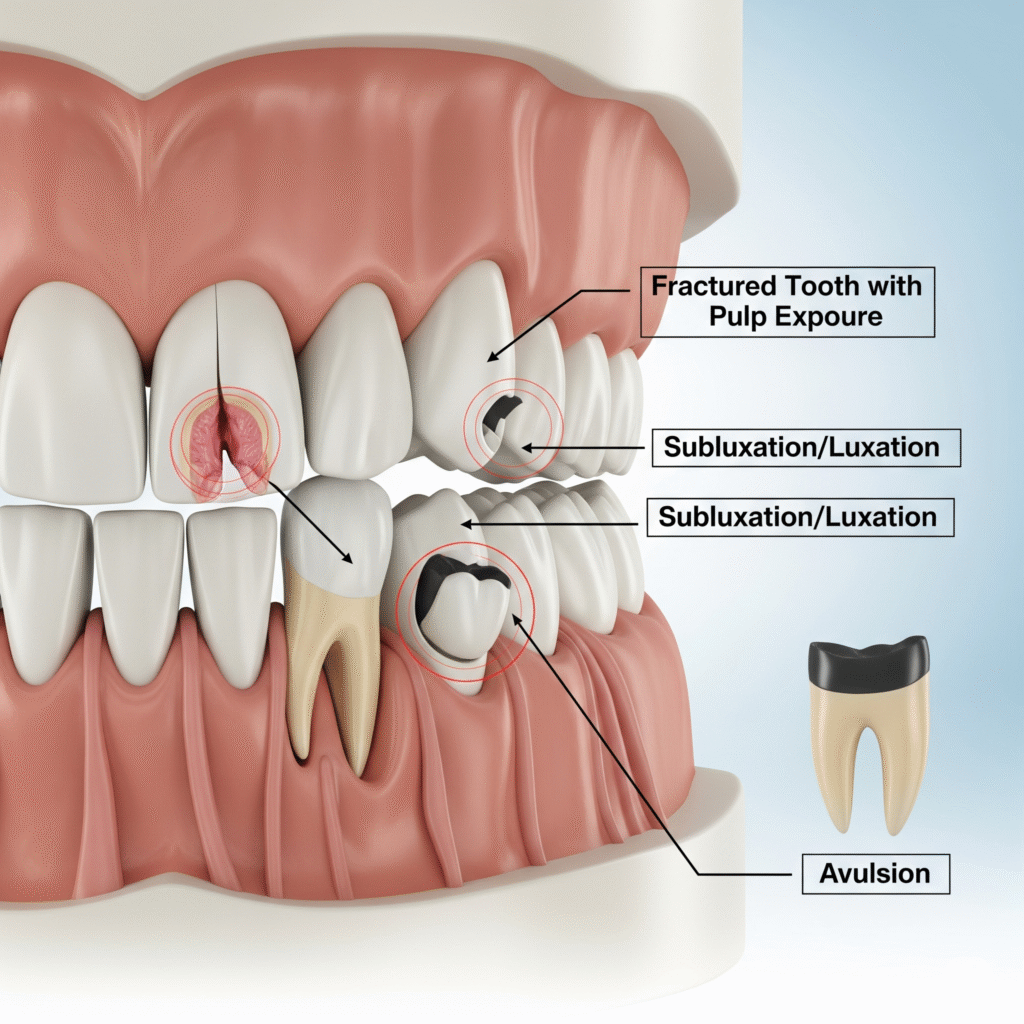Dental trauma refers to injuries affecting the teeth, gums, lips, or jaw due to external force or accidents. These injuries are more common than you might think and can affect anyone—from young children falling during play to adults involved in accidents or contact sports. The good news is, with timely dental care and the right preventive steps, most dental trauma cases can be managed successfully.
Dental trauma can occur in various forms. Recognizing the type is crucial for providing the correct treatment at the right time.
1. Tooth Fractures
A tooth fracture can range from small enamel chips to severe cracks that affect the dentin or even the tooth pulp. These cracks might cause discomfort while chewing or trigger sensitivity to temperature changes. Early detection and treatment are essential to prevent the crack from worsening.
2. Tooth Luxation
This occurs when the tooth becomes loose, shifts from its original position, or is partially pushed into or out of the socket. Seeking immediate dental assistance increases the likelihood of preserving the natural tooth and restoring its stability.

3. Avulsion (Knocked-Out Tooth)
A dislodged tooth is a serious dental issue that demands immediate attention. If handled properly, the tooth can often be saved. Place it in milk or saline and get to a dentist within 30–60 minutes for the best outcome.
4. Soft Tissue Injuries
Injuries involving the gums, lips, tongue, or cheeks often accompany dental trauma. These wounds can result in discomfort and uncontrolled bleeding if not addressed promptly.
Dental trauma symptoms depend on the severity and type of injury. Common signs include:
It is important not to ignore these signs. Prompt dental evaluation can prevent long-term damage and complications.
The treatment depends on the type and severity of the injury. Here’s a breakdown of the most common approaches:
Pain relievers and antibiotics might be prescribed to manage infection and discomfort. Follow-up visits help track healing and catch complications early.
While accidents are often unpredictable, some safety measures can significantly reduce the chances of dental injuries:
Preventing dental trauma is all about being proactive in creating safe environments both at home and outside.
Children are particularly vulnerable to dental injuries. Most cases involve primary (baby) teeth or newly erupted permanent teeth. Falls, bike accidents, and sports are common causes. While baby teeth are eventually replaced, trauma to them can affect the development of permanent teeth.
Immediate dental care ensures that damaged teeth whether baby or permanent are preserved whenever possible. Parents should stay informed and act fast when accidents happen.
Acting fast after a dental injury can make a big difference. Whether it’s a knocked-out tooth or gum injury, the first few minutes and hours are crucial. Quick action can minimize damage, save teeth, and improve healing outcomes.
Ignoring dental injuries can have lasting consequences. Hidden issues like root resorption, infection, or internal bleeding in the tooth may go unnoticed at first. Over time, these complications can lead to severe pain, bone loss, or tooth extraction.
It’s important to understand that neglected dental trauma may lead to irreversible damage to tooth roots or supporting structures, eventually resulting in tooth loss.
Dental trauma can be physically painful and emotionally overwhelming. However, with prompt dental intervention and smart preventive practices, you can minimize long-term damage and restore both function and appearance.
From minor tooth fractures to severe cases like knocked-out teeth, immediate professional attention is key.Safe guarding your teeth begins by staying alert, careful, and taking early action.
Facing a dental emergency or recent trauma? Visit Unidental for personalized care and expert guidance.Our skilled dental experts are ready to guide your healing and protect lasting oral health.
Ideally, within 30–60 minutes—especially for avulsed (knocked-out) teeth—for the best chance of saving the tooth.
Indeed, minor cracks are usually treated through contouring or composite bonding. Larger fractures may need a dental crown.
Gently rinse it (avoid scrubbing), place it in milk or saline, and get to a dentist immediately.
Yes, untreated trauma can harm the tooth's root and surrounding bone, potentially leading to infection or tooth loss.
Hyderabad : +91 6305 971445
Anantapur: +91 70758 90089
Goa: +91 83266 32500
Mon to Sat 10:00AM to 8:00PM
Sun 10:00AM to 12:00PM

Our goal is to provide friendly, caring dentistry with the highest standards in general, cosmetic, and specialist treatments. We strive to be the best dental hospital for comprehensive oral care.
We use advanced dental technology to deliver safe, precise, and painless treatments for every patient.